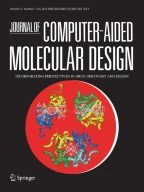Abstract
The process of compound selection and prioritization is crucial for both combinatorial chemistry (CBC) and high throughput screening (HTS). Compound libraries have to be screened for unwanted chemical structures, as well as for unwanted chemical properties. Property extrema can be eliminated by using property filters, in accordance with their actual distribution. Property distribution was examined in the following compound databases: MACCS-II Drug Data Report (MDDR), Current Patents Fast-alert, Comprehensive Medicinal Chemistry, Physician Desk Reference, New Chemical Entities, and the Available Chemical Directory (ACD). The ACDF and MDDRF subsets were created by removing reactive functionalities from the ACD and MDDR databases, respectively. The ACDF subset was further filtered by keeping only molecules with a `drug-like' score [Ajay et al., J. Med. Chem., 41 (1998) 3314; Sadowski and Kubinyi, J. Med. Chem., 41 (1998) 3325] below 0.8. The following properties were examined: molecular weight (MW), the calculated octanol/water partition coefficient (CLOGP), the number of rotatable (RTB) and rigid bonds (RGB), the number of rings (RNG), and the number of hydrogen bond donors (HDO) and acceptors (HAC). Of these, MW and CLOGP follow a Gaussian distribution, whereas all other descriptors have an asymmetric (truncated Gaussian) distribution. Four out of five compounds in ACDF and MDDRF pass the `rule of 5' test, a probability scheme that estimates oral absorption proposed by Lipinski et al. [Adv. Drug Deliv. Rev., 23 (1997) 3]. Because property distributions of HDO, HAC, MW and CLOGP (used in the `rule of 5' test) do not differ significantly between these datasets, the `rule of 5' does not distinguish `drugs' from `nondrugs'. Therefore, Pareto analyses were performed to examine skewed distributions in all compound collections. Seventy percent of the `drug-like' compounds were found between the following limits: 0 ≤ HDO ≤ 2, 2 ≤ HAC ≤ 9, 2 ≤ RTB ≤ 8, and 1 ≤ RNG ≤ 4, respectively. The number of launched drugs in MDDR having 0 ≤ HDO ≤ 2 is 4.8 times higher than the number of drugs having 3 ≤ HDO ≤ 5. Skewed distributions can be exploited to focus on the `drug-like space': 62.68% of ACDF (`nondrug-like') compounds have 0 ≤ RNG ≤ 2, and RGB ≤ 17, while 28.88% of ACDF compounds have 3 ≤ RNG ≤ 13, and 18 ≤ RGB ≤ 56. By contrast, 61.22% of MDDRF compounds have RNG ≥ 3, and RGB ≥ 18, and only 24.73% of MDDRF compounds have 0 ≤ RNG ≤ 2 rings, and RGB ≤ 17. The probability of identifying `drug-like' structures increases with molecular complexity.
Similar content being viewed by others
References
Kubinyi, H., Perspect. Drug Discov. Design, 9–11 (1998) 225.
Clark, R.D., Ferguson, A.M. and Cramer, R.D., Perspect. Drug Discov. Design, 9–11 (1998) 213.
Pearlman, R.S. and Smith, K.M., Perspect. Drug Discov. Design, 9–11 (1998) 339.
Van Drie, J.H. and Lajiness, M.S., Drug Discov. Today, 3 (1998) 274.
Walters, W.P., Stahl, M.T. and Murcko, M.A., Drug Discov. Today, 3 (1998) 160.
Rishton, G.M., Drug Discov. Today, 2 (1997) 382.
Walters, W.P., Stahl, M.T. and Murcko, M.A., in von Ragué Schleyer, P. (Ed.) Encyclopedia of Computational Chemistry, Vol. 2, Wiley, New York, NY, 1998, pp. 1225–1237.
Comprehensive Medicinal Chemistry, 6 Volumes, in Hansch, C. (Ed.) Pergamon Press, London, 1990.
Lipinski, C.A., Lombardo, F., Dominy, B.W. and Feeney, P.J., Adv. Drug Deliv. Rev., 23 (1997) 3.
Ajay, Walters, W.P. and Murcko, M.A., J. Med. Chem., 41 (1998) 3314.
Sadowski, J. and Kubinyi, H., J. Med. Chem., 41 (1998) 3325.
V.V. Shcherbukhin, T.I. Oprea and U. Norinder. Manuscript in preparation.
Olsson, T. and Shcherbukhin V., Synthesis and Structure Administration (SaSA) (1997) developed at Astra Hässle AB, http://www.astrazeneca.com.
Downs, G.M., in von Ragué Schleyer, P. (Ed.) Encyclopedia of Computational Chemistry, Vol. 4, Wiley, New York, NY, 1998, pp. 2509–2515.
Koch, R., The 80/20 Principle, Nicholas Brealy Publishers, London, 1997.
Hansch, C. and Leo, A., Exploring QSAR. Fundamentals and Applications in Chemistry and Biology, ACS, Washington, DC, 1995, pp. 125–168.
Oprea, T.I. and Waller, C.L., in Lipkowitz, K.B. and Boyd, D.B. (Eds) Reviews in Computational Chemistry, Vol. 11, Wiley-VCH, New York, NY, 1997, pp. 127–182, see the reference 138 in particular.
Chan, O.H. and Stewart, B.H., Drug Discov. Today, 1 (1996) 461.
Ungell, A.-L., Drug Develop. Ind. Pharmacy, 23 (1997) 879.
Sadowski, J., Optimization of the drug-likeness of chemical libraries. International workshop on virtual screening, Schloss Rauischolshausen, March 1999.
Oprea, T.I., Hummer, G. and García, A.E., Proc. Natl. Acad. Sci. USA, 94 (1997) 2133 and references therein.
Benet, L.Z., Kroetz, D.L. and Sheiner, L.B., in Hardman, J.G., Limbird, L.E., Molinoff, P.B., Ruddon, R.W. and Goodman Gilman, A. (Eds) Goodman & Gilman's Pharmacological Basis of Therapeutics, 9th Edition, McGraw-Hill, New York, NY, 1996, pp. 3–28.
Oprea, T.I. and Marshall, G.R., Perspect. Drug Discov. Design, 9–11 (1998) 35.
Author information
Authors and Affiliations
Rights and permissions
About this article
Cite this article
Oprea, T.I. Property distribution of drug-related chemical databases*. J Comput Aided Mol Des 14, 251–264 (2000). https://doi.org/10.1023/A:1008130001697
Issue Date:
DOI: https://doi.org/10.1023/A:1008130001697
